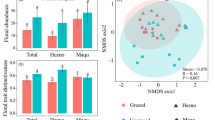Summary
We investigated effects of plant density on floral phenology and potential mating in artificial populations of the outcrossing ornamental Nicotiana alata planted at three densities. Path analysis revealed that increasing plant density yielded significantly earlier peak flowering dates, significantly earlier last flowering dates, and significantly lower plant biomass. Direct effects of density on final flower number were not significant. Variation among replicate plots for first date of flowering was larger than variation among densities, indicating that factors other than density influence floral initiation.
We did not record actual mating, but determined from phenological data the number and identity of potential mates. Increased density had several effects on potential mating patterns and on potential Ne, effective population number. At high density, fewer focal plants flowered for shorter durations. This led to less overlap in flowering time among plants, decreasing the number of potential parental combinations possible among the progeny. Two outcomes of high density, the lower total number of plants flowering and the lower number of plants flowering at most census dates, tended to reduce potential Ne. In contrast, it was low density, where variance in flower number was greatest, that was most likely to yield the greatest reduction in Ne due to variance in progeny number.
At high density the potential for assortative mating among tall plants was much greater and occurred later than among large plants at low density. Much of the potential high density assortative mating occurred late in the phenology of individual plants, when there was likely to be lower fruit set.
We discuss how ecological agents that alter flowering phenology can potentially alter the genetics of populations, the level and timing of assortative mating and, if genetic variation for response to such ecological agents exists, the potential selection regime.
Similar content being viewed by others
References
Antonovics J, Levin DA (1980) The ecological and genetic consequences of density dependent regulation in plants. Ann Rev Ecol Syst 11:411–452
Augspurger CK (1981) Reproductive synchrony of a tropical shrub: experimental studies on effects of pollinators and seed predators on Hybanthus prunifolius (Violaceae). Ecology 62:775–788
Baker RJ, Briggs KG (1982) Effects of plant density on the performance of 10 barley cultivars. Crop Science 22:1164–1167
Crow JF, Kimura M (1970) An Introduction to population Genetics Theory. Harper and Row, New York
Dieringer G (1991) Variation in individual flowering time and reproductive success of Agalinus strictifolia (Scrophulariaceae). Am J Bot 78:497–503
Fripp YJ, Griffin AR, Moran GF (1986) Variation in allele frequencies in the outcross pollen pool of Eucalyptus regnans F. Muell. throughout a flowering season. Heredity 59:161–171
Gentry AH (1974) Flowering phenology and diversity in tropical Bignoniaceae. Biotropica 6:64–68
Heinrich B (1979) Resource heterogeneity and patterns of movement in foraging bumblebees. Oecologia 40:235–245
Kochmer J, Handel S (1986) Constrainst and competition in the evolution of flowering phenology. Ecol Monog 56:303–325
Lacey EP (1986) The genetic and environmental control of reproductive timing in a short-lived monocarpic species Daucus carota (Umbelliferae). J Ecol 74:73–86
Levin DA, Kerster HW (1969) The dependence of bee-meditated pollen and gene dispersal upon plant density. Evolution 23:560–571
Levin DA, Kerster HW (1983) Assortative pollination for stature in Lythrum salicaria. Evolution 27:144–152
Li CC (1975) Path analysis: A primer. Boxwood press, Pacific Grove, CA
Loveless MD, Hamrick JL (1984) Ecological determinants of genetic structure in plant populations. Ann Rev Ecol Syst 15:65–95
Murfet IC (1977) Environmental interaction and the genetics of flowering. Ann Rev Plant Phys 28:253–278
Nei M (1973) Analysis of gene diversity in subdivided populations. Proc Natl Acad Sci USA 70:3321–3323
Paltridge GW, Denholm JV (1974) Plant yield and the switch from vegetative to reproductive growth. J Theor Biol 44:23–34
Primack RB (1980) Variation in phenology of natural populations of montane shrubs in New Zealand. J Ecol 68:849–862
Rathcke B, Lacey EP (1985) Phenological patterns of terrestrial plants. Ann Rev Ecol Syst 16:179–214
Salisbury FB (1963) The Flowering process. Pergamon Press, New York
SAS Institute Inc. (1985) SAS User's Guide: Statistics. Version 5 Edition. SAS Institute, Inc. Cary, NC, USA
Schmitt J (1983a) Individual flowering phenology, plant size, and reproductive success in Linanthus androsaceus, a California annual. Oecologia 59:135–140
Schmitt J (1983b) Density dependent pollinator foraging, flowering phenology, and temporal pollen dispersal patterns in Linanthus bicolor. Evolution 37:124–157
Schmitt J (1983c) Flowering plant density and pollinator visitation in Senecio. Oecologia 60:97–102
Schmitt J, Eccleston J, Erhardt DW (1987a) Density dependent flowering phenology, outcrossing and reproduction in Impatiens capensis. Oecologia 72:341–347
Schmitt J, Eccleston J, Erhardt DW (1987b) Dominance and suppression, density dependent growth, and self-thinning in a natural population of Impatiens capensis. J Ecol 75:651–665
Schwaegerle KE, Levin DA (1990) Environmental effects on growth and fruit production in Phlox drummondii. J Ecol 78:15–26
Shaw RG (1986) Response to density in a wild population of the perennial herb Salvia lyrata: Variation among families. Evolution 40:492–505
Sokal RR, Rohlf FJ (1981) Biometry, Second Edition. WH Freeman and Co. San Francisco, CA
Stephenson AG (1981) Flower and fruit abortion: Proximate causes and ultimate function. Ann Rev Ecol Syst 12:253–279
Waller DM (1985) The genesis of size hierarchies in seedling populations of Impatiens capensis Meerb. New Phytol 100:243–260
Weiner J (1985) Size-hierarchies in experimental populations of annual plants. Ecology 66:334–336
Weiner J, Solbrig OT (1984) The meaning and measurement of size-hierarchies in plant populations. Oecologia 61:334–336
Author information
Authors and Affiliations
Rights and permissions
About this article
Cite this article
Lyons, E.E., Mully, T.W. Density effects of flowering phenology and mating potential in Nicotiana alata . Oecologia 91, 93–100 (1992). https://doi.org/10.1007/BF00317246
Received:
Accepted:
Issue Date:
DOI: https://doi.org/10.1007/BF00317246




